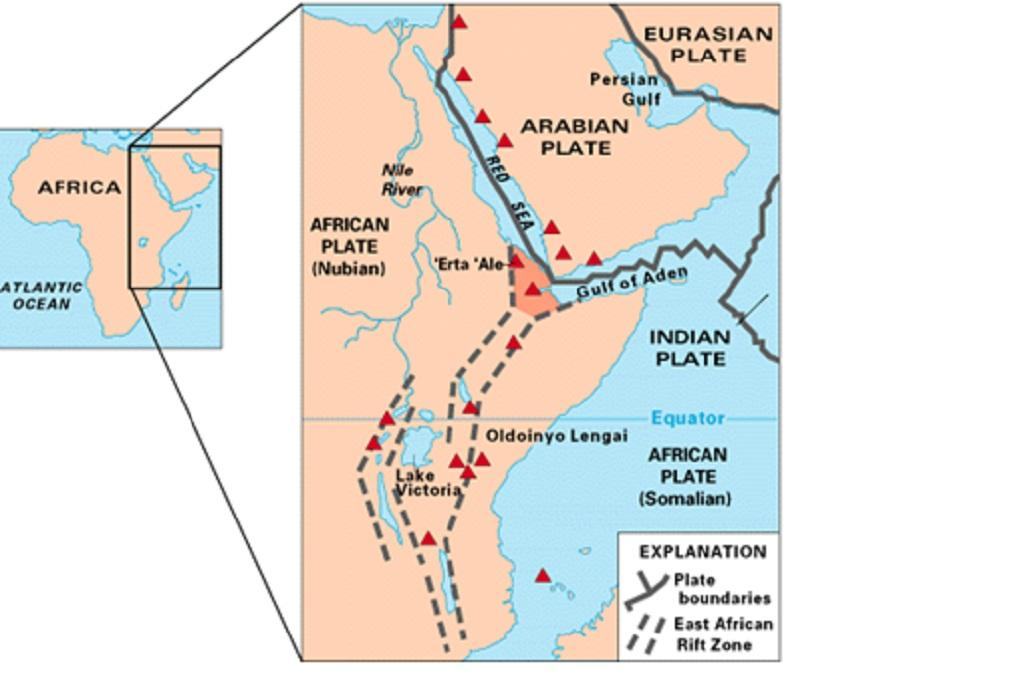Geography
Africa's Rift Valley and the Creation of a New Ocean Basin
- 17 Mar 2023
- 7 min read
For Prelims: Red Sea, Rift Valley, Nubian African Plate, Arabian Plate, Gulf of Aden.
For Mains: Tectonic Plates, Factors Responsible for Africa’s Rifting Plates.
Why in News?
In 2020, a study revealed that the gradual separation of the African continent is leading to the formation of a new ocean basin.
- The division of the continent is connected to the East African Rift (also called the Great Rift Valley), a crack that stretches 56 kilometres and appeared in the desert of Ethiopia in 2005, triggering the formation of a new sea.
What are the Factors Responsible for Africa’s Rifting Plates?
- Factor:
- The three plates — the Nubian African Plate, Somalian African Plate and Arabian Plate — are separating at different speeds.
- The Arabian Plate is moving away from Africa at a rate of about an inch per year, while the two African plates are separating even slower, between half an inch to 0.2 inches per year.
- In the past 30 million years, the Arabian Plate has been gradually moving away from Africa, which has already led to the creation of the Red Sea and the Gulf of Aden.
- Possible Outcome:
- As the Somali and Nubian tectonic plates continue to pull apart from each other, a smaller continent will be created from the rift, which will include present-day Somalia and parts of Kenya, Ethiopia, and Tanzania.
- The Gulf of Aden and the Red Sea will eventually flood into the Afar region in Ethiopia and the East African Rift Valley, leading to the formation of a new ocean.
- This new ocean will result in East Africa becoming a separate small continent with its own unique geographic and ecological characteristics.
- The necessary separation of the Somali and Nubian tectonic plates will take 5 to 10 million years to create a new ocean basin.
- Current Situation:
- While the rifting process has been occurring for some time, the potential division made headlines worldwide in 2018 when a large crack emerged in the Kenyan Rift Valley.
What are the Opportunities and Challenges of this Rifting?
- Opportunities:
- The emergence of new coastlines will unlock a myriad of opportunities for economic growth in countries (e.g., landlocked countries, such as Uganda and Zambia), that will have access to new ports for trade, as well as fishing grounds and subsea internet infrastructure.
- Challenges:
- Displacement and Habitat Loss: Displacement of communities, settlements, and habitat loss of various flora and fauna are consequences that will lead to environmental degradation.
- The necessary evacuation of people and the potential loss of lives will be an unfortunate cost of this natural phenomenon.
- As of 2015, more than 15 million people were internally displaced in Africa, according to the United Nations Environment Programme report on displacement and environment.
- Pressure on Natural Resources: Rapid urbanisation and increased settlements will put pressure on natural resources, leading to a scarcity of water, energy, and food.
- Uncontrolled waste disposal will also be a significant concern.
- New Faults: The separation of the Nubian and Somali plates can result in the formation of new faults, fissures, and cracks or the reactivation of pre-existing faults, leading to seismic activity.
- Displacement and Habitat Loss: Displacement of communities, settlements, and habitat loss of various flora and fauna are consequences that will lead to environmental degradation.
What is Rifting?
- The Earth's lithosphere is divided into several tectonic plates that move in relation to each other at varying speeds.
- Tectonic forces not only move the plates but also have the potential to cause them to rupture, resulting in the formation of a rift and potentially leading to the creation of new plate boundaries.
- Rifting refers to the geological process in which a single tectonic plate is split into two or more plates separated by divergent plate boundaries.
- This process leads to the emergence of a lowland region known as a rift valley.
- Example: Narmada Rift Valley(India), Baikal Rift Valley(Russia).
What is Great Rift Valley?
- The Great Rift Valley is a massive geological formation that stretches around 6,400 kilometers from northern Syria to central Mozambique in East Africa.
- The valley is home to the Jordan River, which flows through the Jordan Valley and eventually empties into the Dead Sea on the border between Israel and Jordan.
- The Gulf of Aden is an eastward continuation of the Rift, and from there it extends southeastward as part of the mid-oceanic ridge of the Indian Ocean.
- In eastern Africa, the valley divides into the Eastern Rift and the Western Rift. The Western Rift, also known as the Albertine Rift, contains some of the deepest lakes in the world.
UPSC Civil Services Examination, Previous Year Question (PYQ)
Q. The Narmada river flows to the west, while most other large peninsular rivers flow to the east. Why? (2013)
1. It occupies a linear rift valley.
2. It flows between the Vindhyas and the Satpuras.
3. The land slopes to the west from Central India.
Select the correct answer using the codes given below:
(a) 1 only
(b) 2 and 3
(c) 1 and 3
(d) None
Ans: (a)







